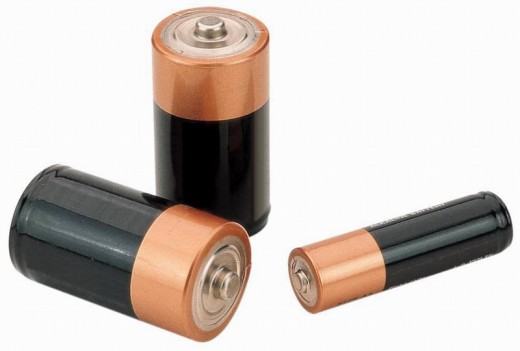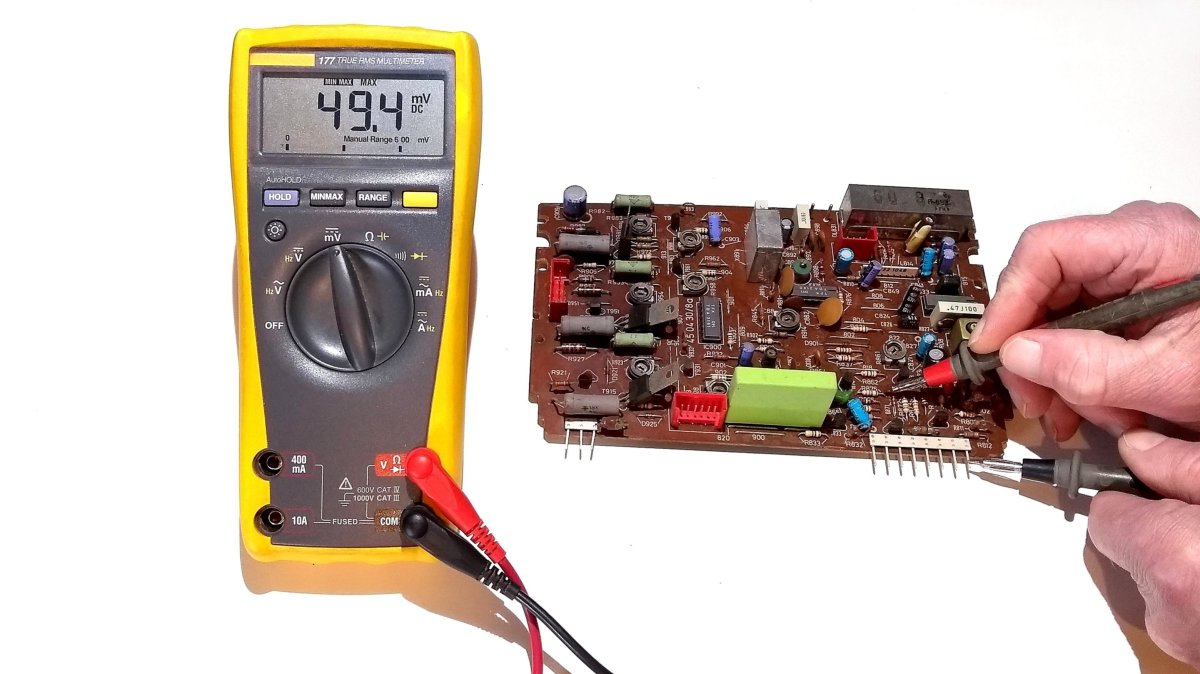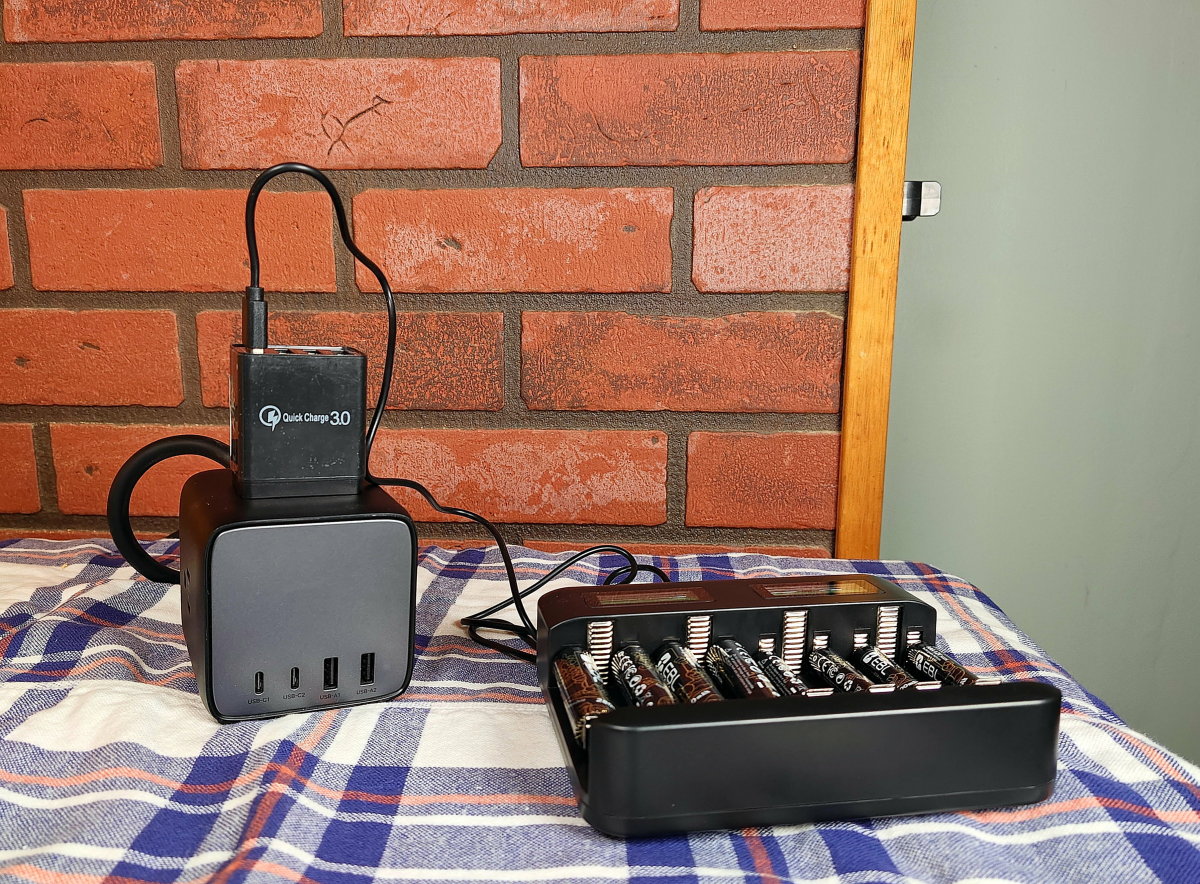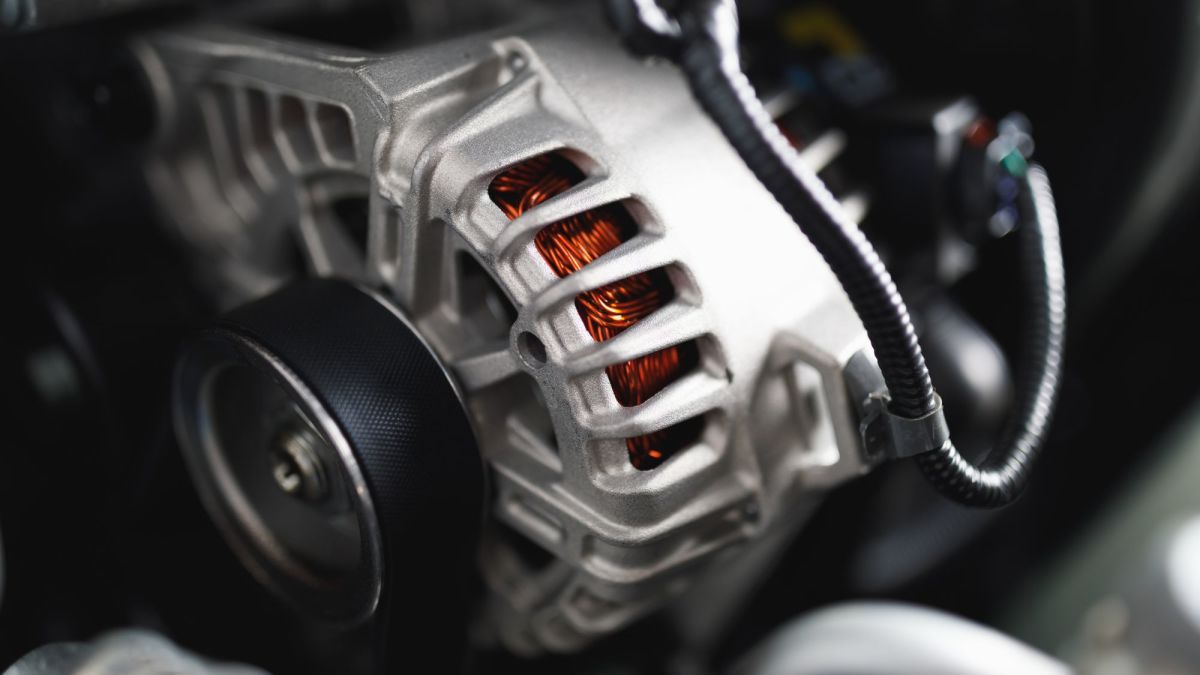BATTERIES, BATTERIES, BATTERIES.

Learn about battery basics and save a bundle.
BATTERIES, BATTERIES, BATTERIES
Realistically, the “batteries” in the photo are not “batteries” at all. They are individual cells and no matter how big they are, they can only produce up to about 1.6 volts each. A 9 volt battery is a true “battery” as it is made up from a “battery” of 6 single cells similar to AAA type cells or flat pancake like cells all wired in series and adding up to 9 volts or better.
If your just starting out in life, particularly with children, you’d be well advised to read this hub and learn “battery” basics because by the time your my age, you will have spent oh somewhere around 4 or 5 billion dollars on “batteries” for everything from clocks to toys, to flashlights, to laser pointers, calculators, walkie talkies, computer mice, and about 300 other items to numerous to mention. Learning what kind of battery to use for what kind of application, when to throw them away, and when to switch an almost dead battery to a lower demand device to get a full usage out of it can and will save you a bundle of money amounting to many thousands of dollars in your lifetime, especially if you have a “battery” of children.
Batteries as we are used to calling them all in general, come in a huge assortment of physical shapes ranging from tubular AA and “C” types, to 9 volts, to flat packs for cell phones. Each individual battery or cell, has it’s own electrical characteristics that are as complicated as it gets. Each requiring laboratory specifications and test results only an electronic engineer with experience in battery technology would throughly understand. Fortunately, we consumers, need only understand a few basics of the more common batteries we use every day to get our monies worth out of these cool little power plants. Here’s what you need to know about the batteries we consume by the billions.
1...AAA cells.
2...AA cells.
3...C cells.
4...D cells.
5...Rechargeable batteries,
That’s about it. However, you absolutely must purchase a multimeter that will easily give you a readout of the state of each of your batteries plus you can use it for testing many other auto and household devices, from light bulbs to fuses. Don’t be intimidated if you know nothing about these meters. One or two lines of instructions and you’ll be relying on your new meter just like a pro. Without a multimeter, you won’t know anything about any of your electronic devices. You can spend as little as 3 or 4 dollars for a small, cheap meter to hundreds of dollars for an industrial model with more functions and much better construction but if all you want to do is read battery voltage, the little cheap meters will do just fine. Meters using a digital readout are a little more expensive but eliminate reading a sometimes complicated analog scale. They simply show you in numbers, say 1.5 or whatever. I would suggest a 20 or 30 dollar investment into a digital meter about the size of your extended hand.
OK, lets get rechargeable batteries out of the way. Mostly AA and AAA these days. These batteries can save you a lot of money simply because they can be recharged and reused up to 1000 times depending on the duty cycle and other usage parameters. Computer mice, small flashlights, and digital camera’s, all can use rechargeable batteries. Buy two or four that come with a 10 hour charger. Stay away from the 30 minute chargers. Your looking at 15 dollars or so but you will get your monies worth out of them provided your kids don’t throw them out when they need recharging (this is a big problem) or you just don’t keep track of them yourself and keep the backups charged. Stick with alkaline if you can’t handle rechargeable responsibilities.
Most consumer rechargeable batteries these days are nickel metal hydride cells that work very well in digital camera’s but remember to have charged backups at the ready. One big problem with rechargeable batteries is that a full charge will only be around 1.35 volts as opposed to a throw away alkaline at 1.6 volts. In a flashlight which requires a higher voltage and a battery with more amperage capabilities, go with the alkaline for general use. The light will be brighter and the “shelf life” or how long it will hold a charge will be much longer than a rechargeable. Use rechargeable batts in light duty, low demand devices like digital camera’s or computer mice.
Next...Cheap, old style carbon zinc batteries will produce 1.6 volts as well but won’t last very long in high demand devices such as flashlights where alkaline will. Carbon zinc batteries, heavy duty or not, can be bought in bulk on Ebay for 10 cents each and are very useful in devices such as small transistor radios and other very low demand items such as wall clocks. As a matter of fact, after you’ve got your multimeter up and running, don’t throw your used alkaline batts away that no longer work something and that read under 1.2 volts or less. They can still power up a wall clock or a small radio for a year or more.
Carbon zinc batteries can save you a bundle if used properly but NEVER EVER leave one in a device that’s left “on” or not used for a long time. When they loose their voltage all together, they will leak nasty acid all over the battery compartment that will corrode most metals all to hell. The same goes for alkaline.
All you need to know about most common batteries is what the voltage means as well as the amperage. Amperage or milliamp (1/1000th of an amp) is the actual current flow through a conductor. Some conductors (or devices) pull much more current (or amps/milliamperes) than others and here is where it’s important to know the device and choose the battery type that’s proper for that device. If you can get away with carbon zinc, go for it. You may replace them many times to equal the cost of a premium alkaline. Remember the shelf life of a carbon zinc battery is about 8 months so don’t go buying 5000 of them. They will still work but that’s when they start to chemically degrade. An alkaline battery shelf life can be several years.
You will also notice the amp hour or AH rating on rechargeable batteries but generally not on alkaline. The rating means (in general only) how long the battery will last. Many variables apply here such as the batteries duty cycle, ambient temperature, and the demands of each different device. This AH rating is determined in the lab and based on what the engineers have designed this battery to power in the field like on for 5 seconds, off for 5 minutes, etc. which most likely will mean nothing to you. Generally however, the larger the AH rating, the longer the battery will last. When charging these batteries, always charge the same brand at one time and always batteries with the same AH rating which on a AAA battery, can be somewhere between 1800ma to 2800ma (milliamperes).
So much for amperage. Voltage is harder to understand exactly what it is. The books call it “electrical pressure” or force that pushes the electrons from hole to hole along the surface of a conductor. Just remember that the voltage of a battery will be the last thing to deplete on your meter so you don’t really have to test the battery for current output. Don’t even try, unless you know what your doing, you’ll surely burn up that segment on your meter or at the least, blow a fuse. By the time the voltage is low say on a AA, about 1.2 volts or lower, there isn’t much available current left at all and remember again, current is the actual electron flow through the conductor.
What’s the difference between AAA’s, AA’s, C cells, and D cells. Cost for one. D cells have become pretty pricey. Actually, they all put out 1.5 volts DC (direct current). Other than that, the bulk of the battery is the only difference. The bigger the battery, the more chemicals in it to produce larger amounts of current when needed, and for a longer period before going bad.
You may hear the words series, or parallel, along the way. When wiring up cells to make a “battery” if they’re wired in series, they will be one after another with the negative (flat) side of the cell connected to the positive side (the button) of the next cell and so on. When finished wiring cells this way, the end voltage will be a total of all the cells in the string. i.e...Five 1.5 volt cells wired in series will result in 5x1.5 which equals 7.5 volts. The voltage increases but the available amperage will remain the same or the capacity of the smallest battery assuming you’ve got AAA’s and C’s or D’s mixed, not a good idea.
Wire cells in parallel, which would be all the positives connected together and the same for all the negatives, and you wind up with the same voltage as one of the batteries but now, the bulk has been greatly increased and the available current for the array will double with each additional battery allowing you to power bigger devices or just have the batteries last longer.
Multi-tap series/parallel circuits can be wired as well but that’s another story.
By the way, use the DC (direct current) scale on your new meter to test all your batteries. You’ll find different, progressing, switchable scales such as 0 to 10 VDC (volts direct current). The next would be 0 to 20 VDC and so on. ALWAYS choose a scale a little higher that your highest battery voltage or series of batteries. This is due to the nature of multi-meters. No one scale can accurately read 1.5 volts and 400 volts on the same scale. If your scale is at 0 to 20 volts and you input 25 volts, analog meters will go off the scale and digital meters will not read at all.
Even a cheap multimeter will have about 3 or 4 scales on it going as high as perhaps 1000 volts AC. Don’t even think about it. At that voltage you’ll need special insulated probes and such. Most meters will also have a range of DC current, AC voltage and current, and Ohms which is electrical resistance. Also very handy when you get to understand what that is. Years ago, we used to play a galvanic skin resistance game at parties with one of my very sensitive Ohm meters. A girl would squeeze one lead between wet fingers, and a guy would do the same with the other lead or test probe. When they kissed, the hard wet, passionate kisses will produce a lower overall duel body resistance reading on the meter in Ohms. What ever couple read the lowest was the hottest and won the contest. A lot a variables here but what the hell, it made for an interesting and fun party game. Especially when your got paired up with your wife and you sneakily let loose of the probe a little that no one can see. Your bad probe connection will produce a very high, less passionate reading regardless of the kiss. What a rat!!
That’s about it troops. Get a standard size plastic tool box and store all your batteries in there. See anold battery in the bottom of your kitchen draw with a thousand other little orphan items, grab it and put it where it belongs. You may just have saved yourself a dollar or more.
Two safety tips:
One... Never store batteries where the positive and negative can be shorted either by a bunch of other batteries or some other metal anything in the storage bin. They will get hotter than a 2 dollar shotgun, leak all over the place. And possibly explode. Tape them together if you have to.
Two...Never try to charge any battery other than rechargeable batteries and only in the proper charging device which is hard to do because in time you will probably only have one charger but lots of different brand batteries. They will explode if the charge rate is wrong or the battery is not rechargeable. Charging batteries will get warm but not hot. If they do, disconnect the charger and stay away from the batteries until they're cool and then check for acid leaks.
Regular batteries and new one’s like lithium and button batteries have come a long way over the years. They are amazing little devices that would drastically change our lives if they didn’t exist at all but like anything else, they can cost you big bucks over the years. Learn how they work, how to take care of, and use them, and you will optimize your investment, know what’s going on with all of your battery powered devices, and in the long run, pollute the earth with dead one’s less than we do now. How many times have you had a device, say with 4 AA batteries stop working and all you could do is throw them all away and replace them with new ones? Lots of times huh? Well don’t do that anymore. Many times only one battery will go totally bad raising it’s internal resistance that causes the 3 others to look bad as well. They may still be usable but not in that string with a high resistance bad one. Now that you have a way to test them all, you can see the voltage of each cell and only throw away the bad one’s. Makes sense to me...








